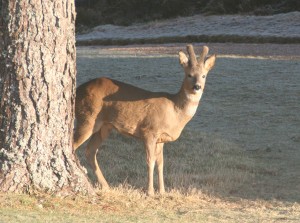 A reader contacted me a few day ago about an interesting experience he had with two roe deer just south of Inverness. They were two bucks and both had their growing antlers covered with what we call velvet. It looked as though the two roe deer were going to fight as their heads went down with antlers pushed forward. However, there was no attack as such just the touching of heads and antlers. The reason for this is a mystery as if deer fight when they are in velvet they generally get up on their hind legs and box with their forelegs. The reason is that the velvet is not only sensitive but also prone to damage which can affect the antler once it has grown and hardened off. With the two roe bucks involved one was an older buck and the other a youngster so perhaps the older one was teaching the younger one a lesson. The photograph shows the much older buck with a thick covering of velvet on its antlers.
A reader contacted me a few day ago about an interesting experience he had with two roe deer just south of Inverness. They were two bucks and both had their growing antlers covered with what we call velvet. It looked as though the two roe deer were going to fight as their heads went down with antlers pushed forward. However, there was no attack as such just the touching of heads and antlers. The reason for this is a mystery as if deer fight when they are in velvet they generally get up on their hind legs and box with their forelegs. The reason is that the velvet is not only sensitive but also prone to damage which can affect the antler once it has grown and hardened off. With the two roe bucks involved one was an older buck and the other a youngster so perhaps the older one was teaching the younger one a lesson. The photograph shows the much older buck with a thick covering of velvet on its antlers.
Antlers have always fascinated people, including myself, and I have a collection of antlers from all the deer species in the UK and they vary considerably. With most species only the males have antlers whilst in one species both male and female have them. In another they have no antlers, neither the male or female. Just occasionally the male will not grow any antlers and this is commonest in the red deer. These antlerless stags are called hummels. What is interesting is that hummels generally grow larger and heavier than those with antlers and can do quite well in the rut competition for the hinds. The reason is that body size is more important than antler size and fights between the stags are far fewer than the media would suggest. The larger the body the more impressive the stag will be to the hinds in the rut.
The sika stags grow antlers as do the roe bucks but the sika hinds and the roe does do not. To see a deer where both male and female grow antlers you only have to go to the Cairngorms to see the reindeer. Both the bulls and cows have impressive antlers and it is believed this is for two reasons. One is that the cows need them to scrape away and get at the food that may be buried in snow. The cows will also defend such food sources and will use the antlers to be dominant. There are two other deer in the UK with one, the diminutive muntjac deer still having doubtful records. After a wildlife park near Beauly closed down many years ago all the deer and goats were released into the wild and this included a pair of muntjac and for a few years there were reliable records for the area and beyond. However, it seems very unlikely there are any still around despite rumours and records. The muntjac buck has very short antlers but on its upper jaw there are a pair of long, prominent fang-like teeth. It will be interesting to see how long it takes for the muntjac to move northward as they are now over the border from England and colonising fast. The other deer species of deer is the Chinese water deer and these are confined to parts of southern England. The bucks have no antlers but have long tusk-like teeth protruding about three inches from the upper jaw.
Tags: highland wildlife
